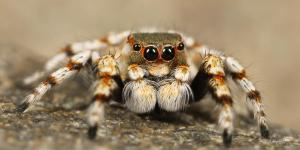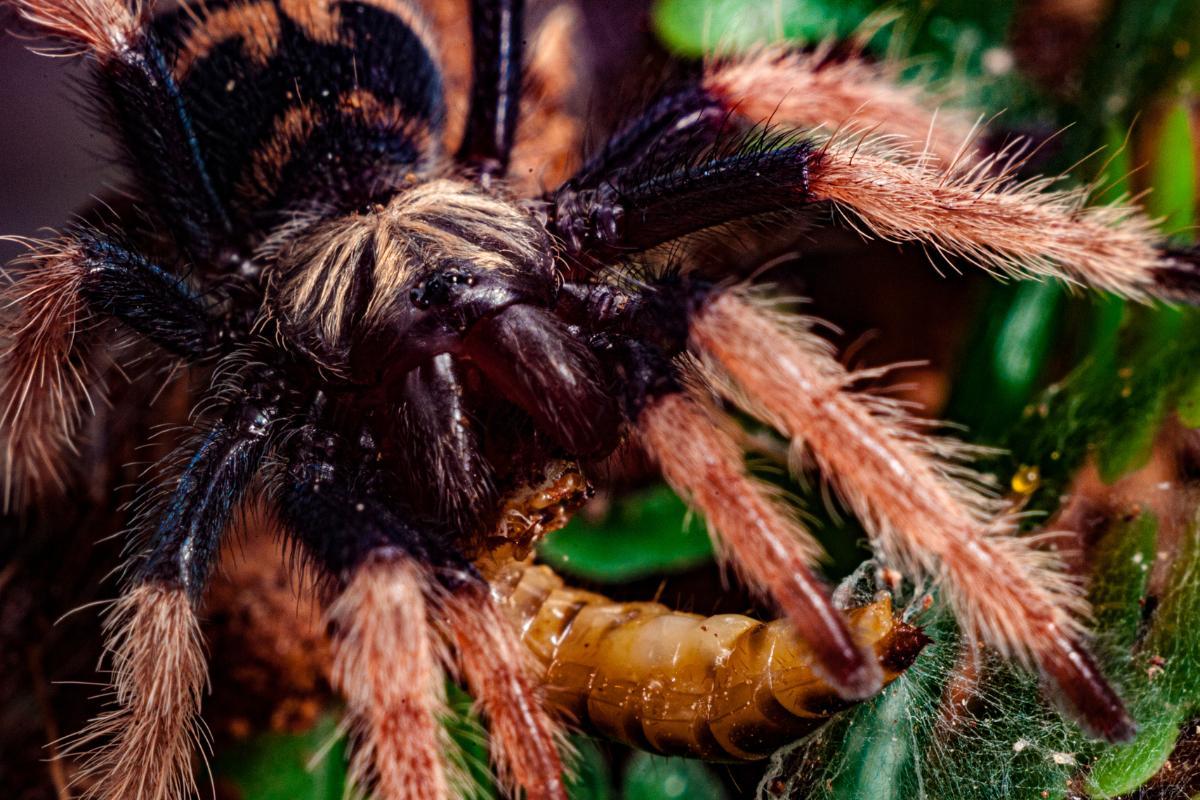What Do Tarantulas Eat?


Over the course of millions of years, tarantulas have developed advanced hunting methods and a variety of dietary preferences as predators. Understanding what these arachnids eat, both in their natural habitats and in captivity, is crucial for appreciating their role in ecosystems and ensuring their proper care as pets. Tarantulas exhibit an extraordinary adaptability in their feeding habits, ranging from tiny spiderlings that feed on prey as small as fruit flies to adult giants that can capture small vertebrates.
In this AnimalWised article, we'll explore what do tarantulas eat across their different life stages, their hunting behaviors, and provide detailed information about proper feeding in captivity.
What kind of food do tarantulas eat?
Tarantulas are opportunistic predators equipped with sensory adaptations for hunting.
Their bodies have specialized sensory hairs (trichobothria) that detect the slightest air movements from potential prey, while their eight eyes, though not providing sharp vision, are effective at detecting movement and changes in light intensity. Interestingly, during threatening situations while feeding, they can deploy urticating hairs from their abdomen as a defensive mechanism.
The feeding process itself is methodical and can take several hours. Before feeding, many species create a small mat of silk that serves as a dining area, helping to contain digestive fluids and keep their feeding space clean. They typically retreat to their burrows or sheltered areas to feed, reducing their vulnerability to predators. They then use their chelicerae to masticate the prey while digestive enzymes break down tissues.
The tarantula creates a food ball containing both liquified and solid portions, which it ingests through its sucking stomach. This efficient feeding process, combined with a slow metabolism, allows tarantulas to survive months without food when necessary.
Fascinated by these eight-legged hunters? Dive deeper into the world of arachnids and discover what makes tarantulas truly unique among spiders.

How do tarantulas hunt their prey?
Tarantulas are ambush predators, and they primarily rely on their highly sensitive trichobothria (sensory hairs) to detect even the slightest air movements from nearby prey.Some species have also developed the ability to detect chemical signatures and vibrations through the ground.
Unlike many spiders, they don't spin webs to catch prey, instead relying on their strength, speed, and venom to subdue victims.
Most species hunt at night or during twilight hours, waiting motionless until prey comes within striking distance. Many position themselves with their front legs slightly raised, ready to strike.
When prey ventures within range, typically just a few centimeters away, the tarantula launches an explosive strike. This attack involves rapidly grabbing and restraining the prey with their front legs while simultaneously delivering a precise bite with their chelicerae (fangs). The venom injection serves dual purposes because it immobilizes the prey and initiates the process of breaking down tissues for digestion.
After capturing prey, tarantulas typically retreat to a safe location, usually their burrow, where they begin the feeding process.
Curious about handling these eight-legged giants? Discover everything you need to know about tarantula safety in our detailed guide.

What do baby tarantulas eat?
Baby tarantulas go through distinct feeding phases in their early development.
Immediately after hatching, they remain in what's called the first instar phase, surviving entirely on their egg yolk reserves until their first molt. After this molt, they begin their independent feeding phase, where their small size necessitates appropriately tiny prey.
During their early feeding stages, spiderlings hunt prey proportional to their size, primarily consisting of fruit flies (Drosophila melanogaster), microcrickets, and other minute insects.
As they grow and molt, they gradually progress to larger prey items such as pinhead crickets, small roach nymphs, and moth larvae. Their hunting skills develop rapidly, though they may initially struggle with larger or more active prey.
Spiderlings feed more frequently than adult tarantulas due to their rapid growth rate and higher metabolism. In captivity, they may accept pre-killed prey more readily than adults, which can be advantageous for their safety and ensure consistent feeding. However, their feeding success is closely tied to environmental conditions, particularly humidity. Their high surface area to volume ratio makes them extremely vulnerable to dehydration, requiring both high ambient humidity and access to water droplets. This moisture requirement is crucial not just for hydration, but also for successful molting, which is frequent during their early growth phases.
In their earliest stages, spiderlings often live communally, tolerating proximity to their siblings. This behavior usually disappears as they grow and establish their own territories. This communal period is also their most vulnerable, as they are highly susceptible to predation, dehydration, and starvation.
What do adult tarantulas eat?
Adult tarantulas are versatile predators whose diet varies based on their size, species, and habitat.
Insects:
Deir diet mainly consists of large insects. Field crickets (Gryllus spp.) and cave crickets (Rhaphidophoridae) are primary food sources, being both abundant and nutritious. Cockroaches (Order Blattodea) are equally important prey, with tarantulas consuming both adults and nymphs. They also regularly capture large moths (particularly Noctuidae), various beetles, caterpillars, and grasshoppers. The size of insect prey typically corresponds to the tarantula's own size, with larger species taking correspondingly larger insects.
Other arthropods:
Beyond insects, tarantulas prey on various other arthropods. Some species specialize in capturing other arachnids, including smaller spiders and even scorpions, though this requires specialized hunting techniques to avoid injury from venomous prey.
They also prey on myriapods such as millipedes (Class Diplopoda) and centipedes (Class Chilopoda), though they tend to avoid species with strong chemical defenses. The ability to judge prey defensiveness appears to be partly innate and partly learned through experience.
Vertebrates:
Larger tarantula species, particularly the Goliath birdeater (Theraphosa blondi) and similar-sized species, occasionally prey on small vertebrates. This includes small lizards (particularly geckos), tree frogs, and occasionally small rodents or birds. However, vertebrate predation is less common than traditionally believed and typically occurs when more conventional prey is scarce or when opportunity presents itself.
In environments where food is scarce or seasonal, like arid regions or during dry seasons, the ability to consume large prey is essential for survival. A single substantial meal can sustain an adult tarantula for weeks or even months, providing a crucial buffer against periods of low prey availability.
While tarantulas can endure long periods without food, they are much more sensitive to dehydration. Regular access to water is crucial for their survival, affecting not only their hydration but also their ability to maintain proper humidity in their burrows and successfully molt. In their natural habitat, they obtain water both from drinking and from the moisture content of their prey, though they will readily drink from standing water when available.
Want to know more about different tarantula species? Check out our detailed overview.

What do tarantulas eat in captivity?
In captivity, tarantulas thrive on a diet that mirrors their natural feeding habits while being practical for owners to provide. The most common staple foods include crickets, cockroaches (particularly Dubia roaches), and mealworms, which are readily available from pet stores and reptile supply vendors. The size of prey items should be proportional to the tarantula's size, generally no larger than the tarantula's body length.
Adult tarantulas in captivity typically eat every 7-14 days, though some keepers feed larger meals less frequently. Spiderlings require more frequent feeding, often every 3-4 days, due to their rapid growth. Food should be offered when the previous meal's remains have been discarded and the tarantula shows active hunting behavior.
Pre-molt tarantulas will refuse food and should not be offered prey during this time. The enclosure should be kept free of uneaten prey items, which can stress or potentially harm a molting tarantula. Water should always be available in a shallow dish, though some species prefer getting moisture from their food and light misting.
Owners should avoid feeding wild-caught insects due to potential pesticide exposure and parasites. Additionally, prey items should be removed if not eaten within 24 hours to prevent stress or potential harm to the tarantula.

How often do tarantulas eat?
The frequency of feeding tarantulas varies greatly and is influenced by the interaction of factors such as age, size, species, reproductive status, and environmental conditions. It is essential to comprehend these factors in order to provide appropriate care:
- Age: spiderlings and juveniles, experiencing rapid growth and high metabolic rates, require more frequent feeding, typically every 3-4 days. As tarantulas mature, their growth rate slows, and their feeding frequency decreases accordingly. Adults may feed weekly to monthly, with some species capable of extended periods between meals.
- Seasonal cycles: feeding patterns often correlate with natural environmental cycles. During warmer months, increased activity levels generally lead to more frequent feeding. On the other hand, colder or drier periods may result in sporadic feeding or periods of inactivity.
- Molting: tarantulas typically cease feeding 1-3 weeks prior to molting, although this can vary depending on species and size, with larger individuals potentially fasting for longer durations. Post-molt feeding usually resumes within 5-7 days for spiderlings and 7-14 days for adults, once the new exoskeleton has hardened sufficiently.
Finally, different tarantula species exhibit different feeding patterns. Desert species, for example, are adapted to irregular food availability and may go months between meals. Tropical species, where prey is generally more consistent year-round, tend to have more regular feeding schedules. Arboreal species, possibly due to their more active lifestyle, may feed more frequently than terrestrial species. Larger species, with their more efficient metabolism and ability to consume larger prey items, can typically sustain longer periods between meals.
If you want to read similar articles to What Do Tarantulas Eat?, we recommend you visit our Facts about the animal kingdom category.
Guillen, J., & Dery, J. (2021). The evolution of metabolic rates in terrestrial arthropods. Frontiers in Physiology, 12, Article 798189. https://pmc.ncbi.nlm.nih.gov/articles/PMC9336175/
Discover Wildlife. (n.d.). Tarantula facts: Everything you need to know about the tarantula. Discover Wildlife. https://www.discoverwildlife.com/animal-facts/insects-invertebrates/tarantula-facts









